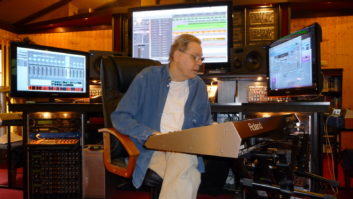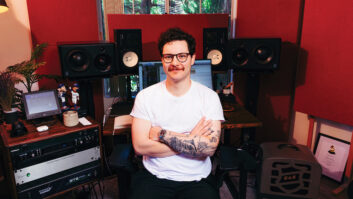Lera Lynn’s new album, The Avenues, produced by pedal steel virtuoso Joshua Grange (k.d. lang, Sheryl Crow, Beck), is rich with texture and emotion. Anchored by Lynn’s spot-on vocal performances, which were recorded live with the basic tracks at Grange’s L.A. studio, the record blends expert musicianship with sparse, thoughtful arrangements. With a band consisting of Lynn’s longtime guitarist Ben Lewis and veterans Jebin Bruni (Fiona Apple, Aimee Mann), bassist Sebastian Steinberg (Fiona Apple, Jon Brion) and drummer Quinn (Tracy Chapman), The Avenues takes listeners on a journey through moody ballads and easygoing up-tempo tunes—each executed in an authentic and refreshingly understated style. Pro Sound News spoke to Lera following a recent sold-out New York City performance.
ON BEING INTENTIONAL:
When I was touring in 2012, opening for k.d. lang, I met Joshua Grange who produced my new record. He was playing pedal steel in k.d.’s band. I had already been recording some demos with my band from Athens at the time, and none of it was really sitting right with me. I spent some time talking with Josh, listening to records and just discussing the production approaches that we appreciated. And he really helped shape my record in a big way—he worked with all of my older, half-written songs, and helped pull it all together and really knew which songs would work best for the record. It is much more cohesive than my first record, which was recorded over several months time and built kind of piecemeal. This record was very intentional in terms of how we were going to record it, who was going to play on it and how much time we had—which was not a lot. I think that this record has really shown me the path to greater potential. I have a much longer way to go, but this is one more step down the trail.
ON DRUMS AND PIANO:
On The Avenues, I think the drums are one of the more unique elements on the record. Some of the songs were in a 6/8 kind of shuffle, but I didn’t want that to be repeated on the drums. So Quinn [drummer] was really creative in avoiding doing the obvious thing. Everything was tracked live—I really like to lock in with the drummer when I am playing, and Quinn and I played really well off of each other in that way. Also, the piano was also a big element on the record as well. Josh has a 100-year old baby grand that has been in his family for a very long time. We chose not to tune it and this brought a really interesting sound to the record. Unfortunately we can’t travel with it, but one of the next steps for the live shows would be to add keys.
ON TRACKING VOCALS:
We actually tracked most of the vocals live with the band and did 15 songs in three days. I went into it thinking they would be scratch vocals, but then we listened back and said, “That’s fine.” We overdubbed some backing vocals and just moved on. For me, it is not about being pitch perfect; it is really about phrasing and how emotionally compelling the vocals sound. I think those things are best captured in a live setting when you are really listening to everyone else and just in the moment and not overthinking it. I was playing guitar and singing at the same time as the band was also tracking.
ON SELF-CONTROL:
I think self-control is one of the hardest things to learn for musicians, but it makes the biggest difference. You have to start from zero to really feel it and have the full scale of emotion and feeling there. I saw Josh play with k.d. lang every day for a month, and whenever a lead guitar player who was fully capable of a notey solo just plays three notes, then you know you have really scored a quality musician.
ON TUNING INTO THE VIBE:
It is a lot of work and you are really trying to get in touch with one of the most ethereal parts of being a human— making music. I think it is incredibly important to have a relaxed but focused atmosphere. All the musicians were great in that way. I have to admit I was a little nervous working with them, because they play with the world’s best singers and songwriters, but they were so nice and easy going, and as soon as we started playing, it all fell into place.
ON MIXING:
We were lucky to get to mix the record at Sheryl Crow’s place. She has a beautiful API 1608 console and I got to run my vocal through her Fairchild—that was great. Josh likes to mix as he goes, so once we got to Sheryl’s, it wasn’t like we were starting from scratch. We ran everything through that API and changed a couple of things here and there, and voila! It was like magic.
ON A CINEMATIC MOMENT:
The very last song on the record is called “Sailor Song”—it’s an older song that I never had the intention of recording or releasing. But after we had tracked everything, Josh recommended we try it. I said ‘OK’. Quinn had this suitcase that he modified with a snare in one side and this reverb spring—he’s got all kinds of weird stuff like that. He was using a mallet for a bass drum sound. We all set up in the living room together and had the big sliding doors open in the studio, and the desert wind was blowing in and there was a mic set up near the piano near the door so it captured it all. We just did one take of that song all the way through and it was a pretty special moment—to see it all come together was pretty cinematic.







